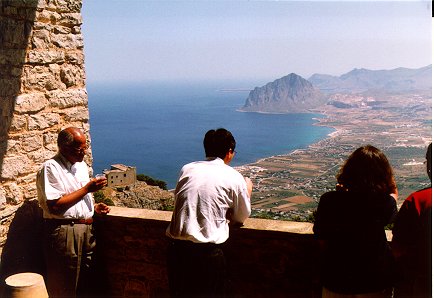

The breathbreaking view you may enjoy during
coffee breaks in S.Domenico Lecture Hall
the 27th crystallographic course at the "E. Majorana" Centre,
Erice, Italy
a Nato A.S.I. and a Euroconference, TMR Programme, EC, Bruxelles
sponsored by the International Union of Crystallography
and by the British Council
IMPLICATION OF MOLECULAR AND MATERIALS STRUCTURE FOR NEW TECHNOLOGIES. A REPORT.
28 May - 7 June 1998, Erice, Sicily, Italy
Co-Directors
Judith A. K. Howard, Durham and Frank H. Allen, Cambridge
The Advanced Study Institute was a major development
of themes first expressed at two earlier Erice Crystallography Schools in 1985
and 1991. These schools recognised the fundamental value of the chemical and
crystallographic knowledge that is obtained from each new crystal structure
determination. For the first time, they began to deal with the application of
the huge reservoir of knowledge that is embodied in more than 250,000 existing
crystal structures, so as to address research problems in structural chemistry.
Over the past seven years, there have been major developments in the application of crystal structure analysis to the design of new materials, and essential links between experimental chemists, crystallographers, database experts, molecular modellers and theoreticians are being forged. The 1998 School reflected these developments, with lecturers and participants being selected from a wide range of disciplines so as to further strengthen this synergy through broad debate and personal interactions.
92 "students" - coming from 31 different nations - attended a total of 19 main lectures, supported by shorter lectures from selected participants; this teaching activity provided both background and current state-of-the-art in the following subject areas:
* modern diffraction techniques, novel radiations
and experimental conditions
* computational modelling using force-field and ab initio molecular orbital
methods, and their interplay with experimental methods
* hydrogen bonding and other intermolecular interactions
* supramolecular assembly and crystal structure prediction
* databases and knowledge bases derived from experimental results
* practical examples of materials design
All of the lectures provoked considerable discussion, with particular interest being shown in (a) the resurgence of powder methods of structure determination, (b) ultra low-temperature crystallography, (c) the improved understanding of hydrogen bonding that is afforded by the combination of geometrical observation with molecular orbital approaches and ab initio alculations, (d) improvements in the computational modelling of non-organic species, and (e) the whole area of supramolecular assembly and crystal structure prediction, which provoked extremely lively discussion amongst protagonists of two rather different approaches: those based on potential energy calculations, and those based on direct experimental observations of crystal packing - the knowledge-based approach.
The formal lectures were backed up by five different hands-on computer tutorials, which allowed all participants to become aware of state-of-the-art software in crystallography, database analysis and computational modelling, and which permitted close interaction with software designers using modern equipment. Longer discussion sessions were also arranged, involving groups of lecturers with related subject material and smaller groups of participants. Finally, the course was rounded of with two evening poster sessions which allowed participants to display and discuss their own work. These sessions sparked some of the most productive interactions of the whole course, with discussions continuing long after the official closing time.
Materials design is now a major area of scientific endeavour with wide-ranging applications in pharmaceuticals, agrochemicals, catalytic processes, electrochemistry and molecular switches, super- and semiconductors, etc. Thus, the choice of topics covered here was very necessarily limited to cover essential background and specific examples. Nevertheless, the success of the course can be measured by two criteria (a) the very high (>95%) attendance rate that characterised the whole 10-day scientific programme, and (b) the number of cross-disciplinary discussions that, according to feedback received by the Co-Directors, seem likely to result in a variety of collaborative research projects in the near future.
During the final session the traditional Vaciago Award (to a young "student" most active in the lecture hall) was awarded to Frederick Krebs, Odense, Denmark
the photo includes all participants,
grouped in the S. Domenico upper floor.
In the first row, on ground, you may recognize
from left, ……., Joel Bernstein, Paola Spadon, Maria Rosa D'Acunto,
Andreita Ros,
John Irwin, ……, Lucia Maini, …….., Carlo Maria
Gramaccioli Seated just behind, Frank Herbstein, Dario Braga,
Fabrizia Grepioni,
Gautam Desiraiu, Carolyn Brock, Elena Boldyreva, Frank Allen,
Judith Howard, Roald Hoffman, Ray Davis and Jack Dunitz
Another photo was sent by Sofia Macedo, Lisbon.
Amongst the few breaks in the intense scientific activity it is worth mentioning the great success obtained by the internationally renown organist Jennifer Bate, London, who played classical and typical british music in the Benedictine Abbey, S. Martino delle Scale, just above Monreale, Palermo.
A Nato ASI and a Euroconference award and financial support from International Union of Crystallography and British Council are gratefully acknowledged.
Some photos of Erice and surroundings have been made available by Michael Quayle and Gareth Lewis, Bristol, participants at Erice 1998.
The announcement was first posted on 11 Dec 1994 by Lodovico Riva di Sanseverino
Updated on Dec 24, 1996; Apr 11 and July 8, 1997. The report - mostly written by the Directors - has substituted the announcement on Aug 7, 1998. The photo was added on 29 Oct 1998
Lodovico Riva di Sanseverino, fax +39 0512094904